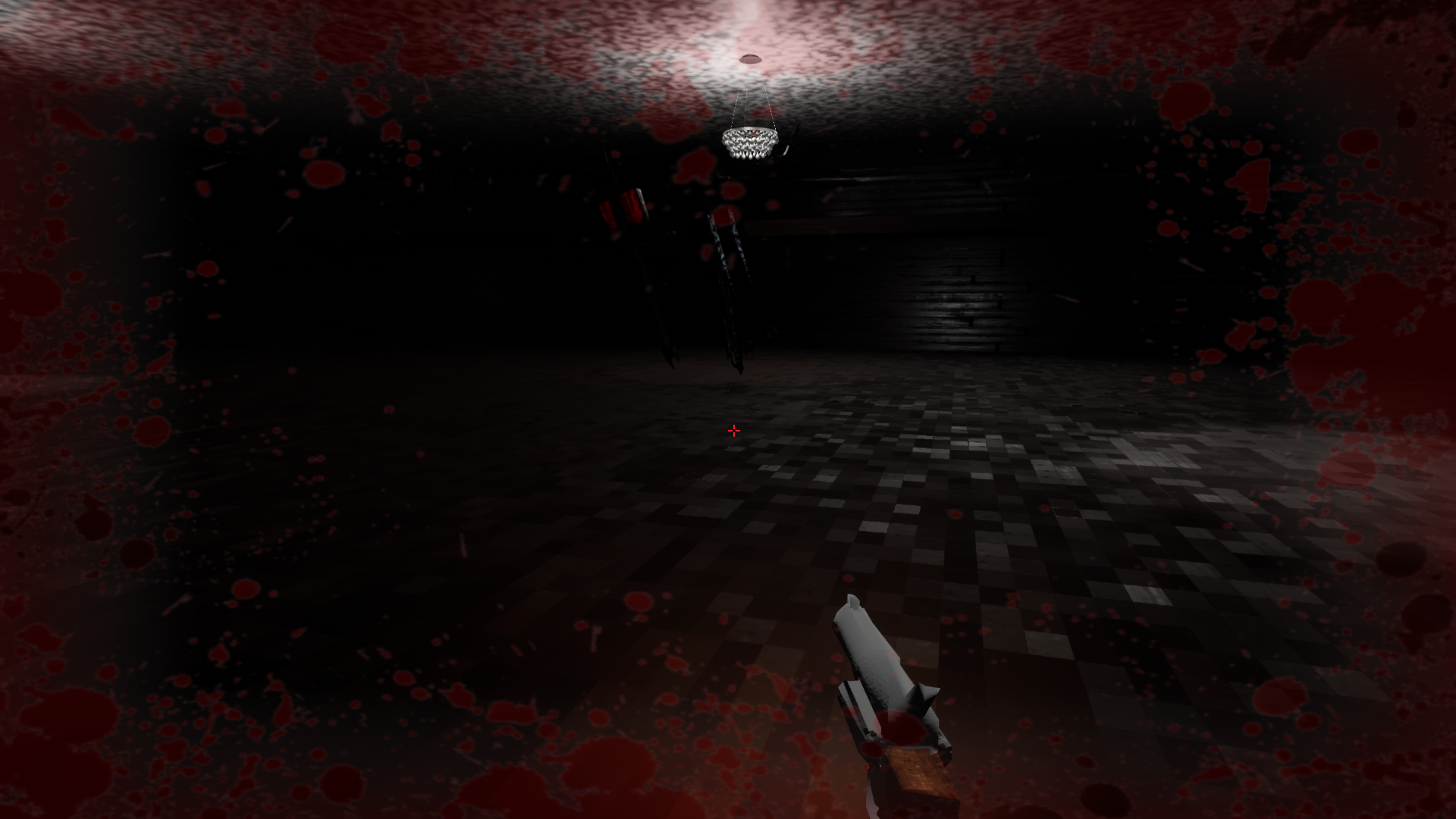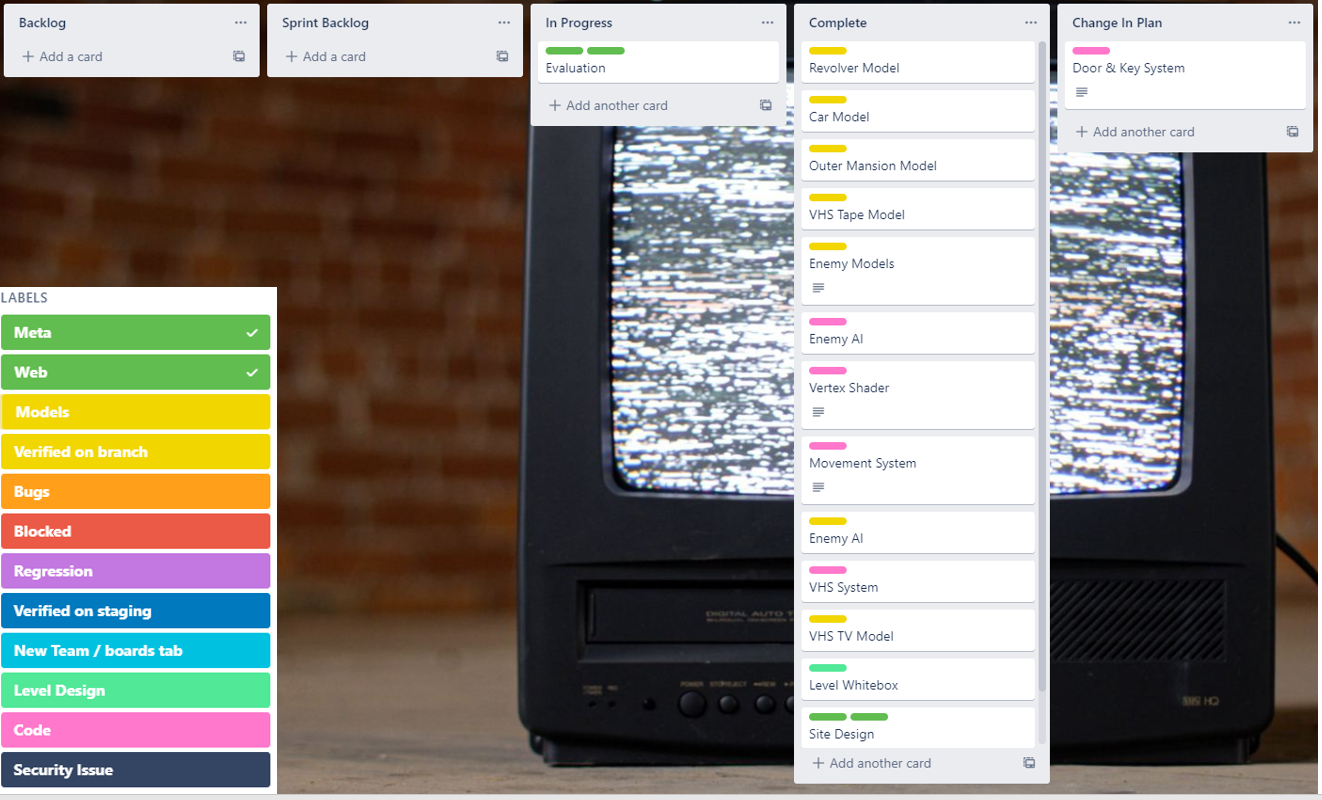
VHS Horror – Reflective Blog
Candy Crab Games, Connor Bulmer – 1442549
Introduction
As discussed in my GDD (Bulmer, 2021) – The goal was to make an old school horror game reminiscent of older horror games in terms of the art style but with FPS Gameplay based within a mansion with puzzles relying on a VHS system. The outcome of the project is an old-school styled FPS horror game within the mansion where the player can move between the dimensions and fight 2 different AI enemies.
I would consider the project a relative success, the demo shows off the idea behind the game and has all the systems needed for the full game working as intended, the games direction did change slightly, as the player has unlimited ammo allowing for more active combat scenarios.
Industry Studio Project
Practical Work
My vision of the player’s experience, as outlined in the GDD is based on 4 design pillars:
- Discovery – having a feeling of discovery while playing.
- Fear – the constant feeling of tension leading to fear.
- Triumph – when a battle is won or mystery solved.
- Minimalism – Minimal UI to help immerse and hinder knowledge.
The demo does capture all of these design pillars, although admittedly some more than others, as the player should have the intended feelings and emotional responses during gameplay, how this is achieved has slightly changed.
While still an FPS horror where the player explores a mansion while solving puzzles (discovery, triumph) and fighting enemies (fear, triumph) with minimal UI clutter (minimalism), the idea of resource management is a factor in making the player fearful was scrapped to allow for more combat-driven triumph and more unique combat scenarios that low ammo wouldn’t accommodate.
In terms of technicals, the game was built in Unreal Engine 4 (Unreal Engine, 2019) through Blueprints (Unrealengine.com, 2021) with some texturing and modelling done via Maya (Autodesk.co.uk, 2018) (via the box modelling (Wikipedia Contributors, 2019) approach and ensuring 0 Ngons) and Substance (Substance 3D, 2021) and some obtained through the asset store. (Unreal Engine, 2021) Sound used within the game was taken from FreeSound (Freesound.org, 2015) and modified with Audacity (Audacity, 2021). Animations within the game are from Mixamo (Mixamo.com, 2021) with an animation blueprint used to manage them in-engine.
The use of these tools worked out well, as they gave me everything I needed to build out the game with minimal issues even with my limited skill set, my experience using all of the tools (outside of an initial learning curve) was also fairly good, I did have issues in some areas though:
- Models – far too small and needed lots of scaling, UV unwrapping was automatic which caused issues.
- Animations – animations made were too jarring and janky for use in-game, Mixamo was really useful here, animations still arent perfectly in sync with the zombie’s attack.
- AI – A lot more to chew than I initially thought, with lots of bug fixing and tweaks needed.
- Bugs – Fixing bugs was time-consuming and debugging in blueprints can be a challenge.
- Compilation – compiling/publishing the game had issues with this build that required lots of testing and fixing.
As a first-year student with little experience in a lot of areas of game development, this experience gave me lots of knowledge and insight in many areas and overall I would say that I have learned a lot, including things such as:
- 3D Modelling – everything from basic box modelling to UV unwrapping and texturing.
- Animations – understanding how they work in-engine and building animation blueprints.
- Unreal Engine – full understanding of working in the engine and coding functionality via Blueprints, fixing bugs and code logic
- Game Design principles – writing game design documentation, planning core game loops, game mechanics etc.
Project Management
In terms of managing the game project, I opted to use the Agile project management (Apm.org.uk, 2015) methodology, an approach to project management where tasks are broken down into several smaller tasks that are then done in sprints, this allows for velocity and adaptability in software development.
I created an asset and code list as part of my game design documentation that included everything I would consider necessary to produce a minimum viable product or demo for the game to show off the concept, each of these was then assigned a task, each task would then correspond with a card on Trello (@trello, 2021), which was then added to a backlog to be done in sprints and moved to completion when done, tasks were also colour coded to aid with quickly viewing what related to which part of the game and milestone.

In terms of what the milestones were for the project, these were some of the project milestones:
- Documentation
- Models
- Sound
- Blueprints
- Whitebox
- basic functionality
- polish
In terms of the deadlines for each of the phases in the project, all deadlines were met.
I feel that this approach to project management for my game worked out really well, as it helped to ensure that there was relatively little scope creep and it also aided in keeping the game close to its initial vision. I found the main benefit of working with this methodology was how it broke down what could have been seen as scary daunting tasks into much more manageable chunks and moving over tasks regularly gave a constant feeling of progression which helped to motivate me to keep going. As discussed before, it also helped me to have clear milestones and meet deadlines with minimal issue.
I feel like this was a good learning experience, as while I have experience with working under the agile methodology, using it to build out a game helped me to further understand the methodology and improve my experience and skill in using it.
Conclusion
To conclude, I would consider the project a success from both the design and project management angle, as the game project shows off the idea behind the game and closely matches my initial vision, and shows off enough for the end-user to get an idea behind the goal of the full game, even if the direction changes slightly on the resource management angle.
From a project management perspective, the use of agile/scrum and Trello to manage the project allowed for fast iteration and a clear idea of where to go next while allowing for any needed flexibility.
I learned a lot from this experience in many areas that I am keen to use in future game design projects.
Bibliography
Bulmer, C., 2021. VHS Horror – Game Design Document. 1st ed. [ebook] Colchester, pp.1 – 15. Available at: <https://www.connormakes.games/wp-content/uploads/2021/03/VHS-Horror-Game-Design-Document.pdf> [Accessed 1 June 2021].
Unreal Engine. (2019). Unreal Engine | The most powerful real-time 3D creation platform. [online] Available at: https://www.unrealengine.com/en-US/ [Accessed 1 Jun. 2021].
Unrealengine.com. (2021). Blueprint Visual Scripting. [online] Available at: https://docs.unrealengine.com/4.26/en-US/ProgrammingAndScripting/Blueprints/ [Accessed 1 Jun. 2021].
Autodesk.co.uk. (2018). Maya 2018 | New Workflow & Character Creation Tools. [online] Available at: https://www.autodesk.co.uk/campaigns/maya [Accessed 1 Jun. 2021].
Wikipedia Contributors (2019). Box modeling. [online] Wikipedia. Available at: https://en.wikipedia.org/wiki/Box_modeling [Accessed 1 Jun. 2021].
Substance 3D. (2021). Substance Painter | Substance 3D. [online] Available at: https://www.substance3d.com/products/substance-painter/ [Accessed 1 Jun. 2021].
Unreal Engine. (2021). Marketplace – UE Marketplace. [online] Available at: https://www.unrealengine.com/marketplace/en-US/store [Accessed 1 Jun. 2021].
Freesound.org. (2015). Freesound – Freesound. [online] Available at: https://freesound.org/ [Accessed 1 Jun. 2021].
Home (2021). Home. [online] Audacity ®. Available at: https://www.audacityteam.org/ [Accessed 1 Jun. 2021].
Mixamo.com. (2021). Mixamo. [online] Available at: https://www.mixamo.com/#/ [Accessed 1 Jun. 2021].
Apm.org.uk. (2015). Agile project management. [online] Available at: https://www.apm.org.uk/resources/find-a-resource/agile-project-management/ [Accessed 1 Jun. 2021].
@trello. (2021). Trello. [online] Available at: https://trello.com/en-GB [Accessed 1 Jun. 2021].
